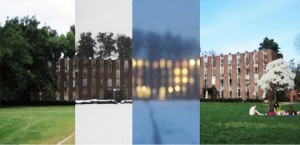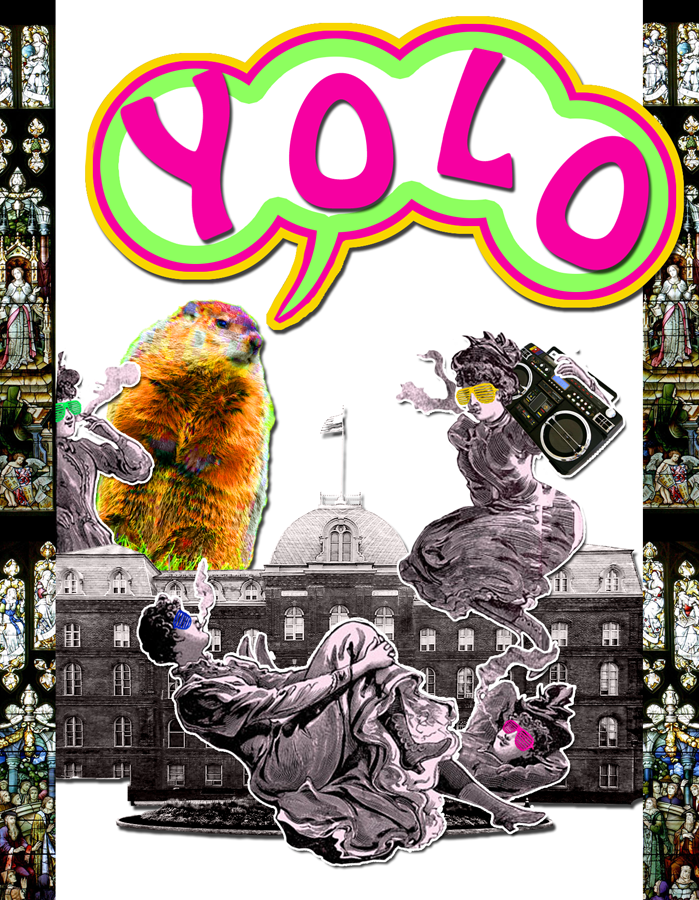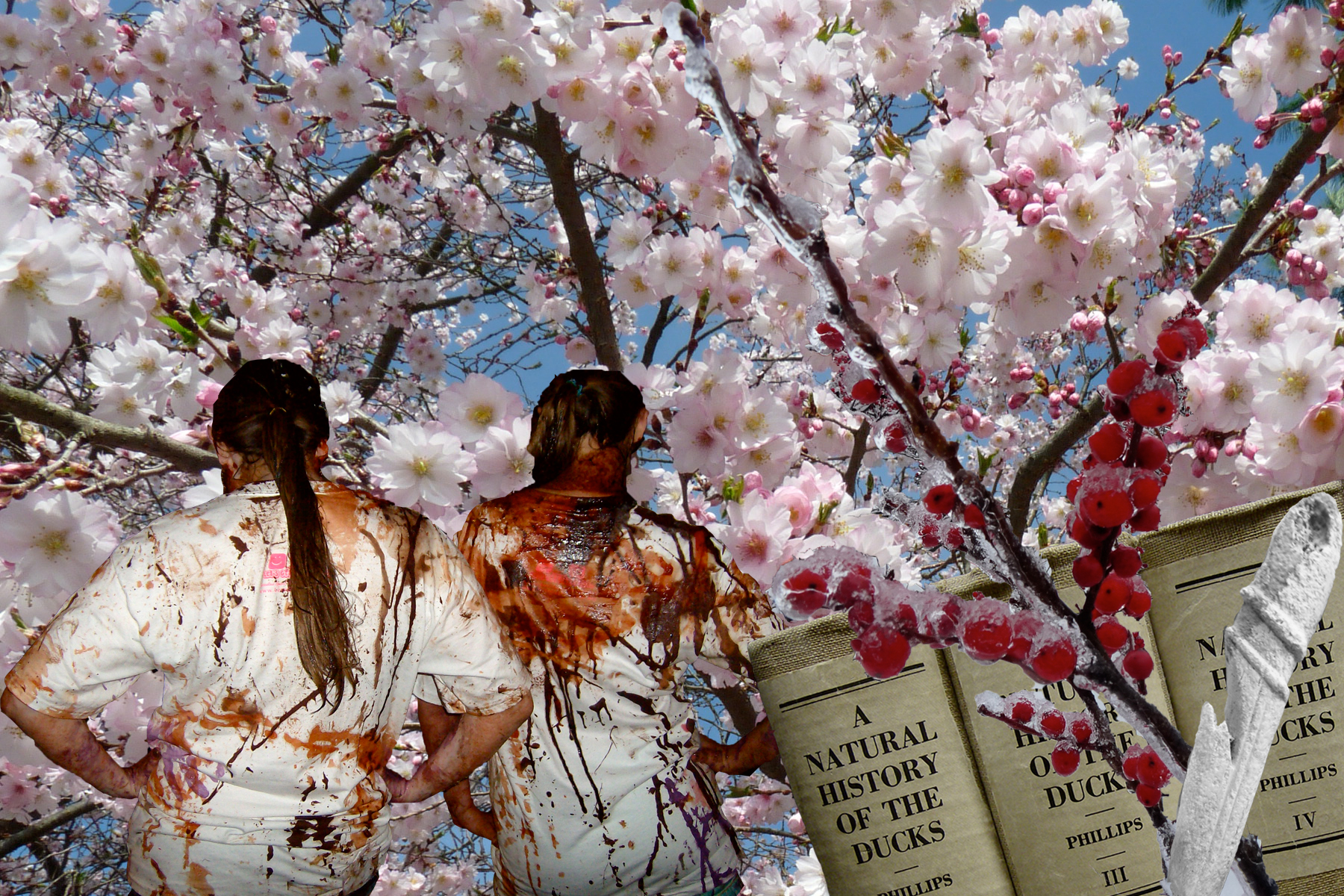When I think of Vassar I think of Noyes. I’ve lived here for the past three years, been a part of the Noyes House Team and have trudged through the mud pit of Noyes circle too many times to count. But what I love best is how beautiful Noyes looks in every season, and this view in particular, which greets me every time I come back home with a giant semi-circular hug. I gave the image this artsy filter because Noyes was a great source of inspiration for me last year during my drawing class, and I’ve spent countless hours hauled up in the basement or lying out on the grass trying to capture in my sketchbook in what I love best about this building.
Monthly Archives: April 2012
Remediating Vassar’s Thompson Memorial Library
The idea behind remediating an image that represents Vassar was to learn basic aspects of photoshop while also applying some concepts of remediation from our class discussion. I have chosen to take an image of the Thompson Memorial Library in the winter time and overlay some images of Vassar students (some of my friends). Behind the library you can see Matthew Vassar looming above in the clouds looking over his creation. The image is my commentary on Vassar student life: students enjoying themselves, getting ready for the spring by dressing like it’s 80 degrees out when it’s really in the 50’s, while also constantly being reminded of the massive amounts of work awaiting them in the library. I added Matthew Vassar, the ominous being we speak so fondly of as Vassar students, as a tribute to all the glory that is Vassar!
Archaeology Games
Try your hand at this archaeology game made by the BBC.
The game puts you in the shoes of an archaeologist searching for an ancient burial site with a limited budget and under time pressure from developers. You need to do research at the local records office, take aerial photos of the land, and choose what methods to use in your excavation.
The game is quite unusual, in that it puts CRM archaeology in context and allows the player to see the “big picture” in an archaeology project- that which takes place outside of the actual excavation. I lost the game (and the quarry company destroyed my site) on my first try because I was too slow and careful with digging and went over budget.
In a basic search of online archaeology games out there, you’ll probably find that most aren’t really games at all, but “clickable” animations or quizzes. However, the best educational games (and Hunt the Ancestor only begins to scratch the surface of possibilities here) are immersive and immediate- you learn not by being asked to read facts, but by living a virtual life and having virtual “hands-on” experience. Actually making decisions and dealing with results makes programs like this one much more compelling and therefore better instruments of public archaeology.
Archaeology in the Classroom
This week we talked about one of the most effective ways to get knowledge of archaeology out to the public: teaching it in classrooms. The focus was on grades K-12, though we talked a little about college courses in archaeology as well. Of the many case studies we read, one of the most emphasized ways to introduce archaeology to students was to find ways to make archaeology work for teachers. In other words, since teachers have to teach their students a specific set of topics and skills in order to meet state requirements, archaeologists should work with teachers to figure out how archaeology can be used to teach things that are required. Archaeology, being quite interdisciplinary in the real world, can be used to teach map-reading, math skills, the scientific method, history, music, and values, such as respecting different cultures.
The articles we read also offered tips for making archaeology really stick in students’ minds. Hands-on activities were a common theme. Whether in the classroom, at an archaeology event, or in a museum setting, crafts like pottery making and activities like throwing atl-atls were very popular. If these activities are accompanied by a lecture, question and answer session, or a handout with background information, they can be more than just entertainment for kids. Students have different learning styles, and receiving and interacting with information using different sensory modalities can lead to improved information retention for all. Another tip for making an effective archaeology presentation is to learn about the people in your audience beforehand, and craft the presentation with their ages, skill levels, and interests in mind. Finally, many of the authors we read could not emphasize enough the importance of taking advantage of the expertise of any educators you are working with, rather than just treating them as another person to be educated. They likely have more teaching experience than you might, and can help your archaeology presentation be as effective as possible. However, it is very important to communicate with your teacher-collaborators when crafting an archaeology presentation. Often, your goals as an archaeologist (to gain support for archaeology, to teach stewardship) may be different from the teacher’s goals (entertain the kids, maintain discipline, teach a variety of subjects and skills). Make sure that this is something that you discuss in the planning stage so that everyone benefits from bringing archaeology into the classroom.
Remediating Vassar Imagery
It’s always fascinated me that VC students take a remarkable amount of pride in the college’s history of academic legitimacy, but have no qualms about re-purposing that history ironically (the Victorian lady trope, e.g.) Cultural legitimacy indeed.
(Feat. Main Building, classy smoking Victorian ladies, the library’s stained glass windows, and a whomp-whomp)
Experiment in Remediation: My Vassar Experience
Discussion Topic: Archaeology as Social Justice
The topic of my discussion was “Archaeology as Social Justice.” This week, we dealt with defining some more theoretical terms relevant to the idea of community and public archaeology. Some other goals of this week’s discussion were to answer questions like How can we address issues of class using archaeology? What is the difference between critical archaeology and post-processual archaeology? For critical theory, we looked to Randall McGuire, a professor of Anthropology and archaeologist who received his PhD at the University of Arizona in 1982. Critical theory stems from consumerism: fed products that ultimately perpetuate class structure. In critical theory, class relations are reorganized by ideology. An example of this dominant ideology is meritocracy, which is the idea that people start on the same playing field and succeed by solely by working hard. Ultimately, the goal is to bring these ideologies to light so that people can recognize and understand them.
Processual archaeology is essentially deductive positivist theory, which adopts a strict way of performing scientific study. The idea here is to create studies that are replicable with refutable or non-refutable hypotheses. Processual archaeology seeks to explain why societies are more complex than others. Post-processualism emerges against processual archaeology, coming out of post-structural thought. Post-processualism is kind of like an umbrella of techniques against processualism, including meaning, critique, and transformation. The critique aspect of post-processualism deals with the researcher knowing his or her biases and understanding context. Transformation of post-processualism deals with creating a new practice.
We talked a little bit about feminist literature and research relating to archaeology, which largely deals with the intersecting of categories of experience with each other and the relationships among domination, power, and balance. Marxist archaeology puts class above other categories of experience. Indigenous archaeology intersects with some of the feminist perspective but asks the question, how do these result in colonization? Ultimately it is important to understand how we create and use knowledge. In order to transform archaeology, we must understand how we create knowledge.
Burial Grounds, Archaeological Sites, and the Oil Pipeline
This article by Katie Fretland of the Associated Press serves as a reminder that the lands that we live and build on today have been lived, built, and died on by other people for millennia. The Keystone XL oil pipeline is meant to improve the United States’ oil transportation system, the whole thing extending from Canada to the Gulf Coast. The pipeline is already a contentious topic among people who are concerned about its impact on the environment, but there are others who have concerns as well. This article focuses on the concerns of Chief George Thurman of the Sac and Fox Nations, specifically that the portion of the pipeline running from Oklahoma to Texas will interfere with Native American burial sites. He and others believe that there might be unmarked graves in the proposed route of the pipeline.
TransCanada, the company in charge of building the pipeline, does have archaeologists to help determine when historical sites, artifacts, or graves might lie in the path of construction. They claim that construction ceases when any such sites are found, and that when they find a site, they then work with the relevant tribes or concerned parties to figure out how the situation should be handled. In Oklahoma alone, seventy archaeological sites have already been identified in the preliminary survey of the area where the pipeline is to be built. It will be interesting to see what is unearthed during construction, and whether any compromises are made on TransCanada’s part if, in fact, burial sites are uncovered.





